Western Sydney Wanderers and Macarthur clashed over the weekend in a game full of tactical retaliation. Dwight Yorke has been only experimenting with his tactics for over six months in his first-ever managerial role. Marko Rudan, the experienced Australian coach has well shaped the team filled with creativity and energy.
In 2021, he was dissatisfied with Aston Villa’s choice to appoint Steven Gerrard instead of him as the club’s head coach. However, he has constantly looked for an opening. Macarthur seemed to be an ideal team as the club was recently founded in 2017.
Yorke has the taste of what the biggest defeats feel like as a coach. WSW’s attack could not be tolerated by Yorke’s men as they kept on suffering until the very end. Some of Macarthur’s disappointments have been run through in this analysis.
This tactical analysis will look into how Rudan had his team play against Macarthur with his tactics. This analysis will also provide Yorke and his side with improvements to the areas of the team in which he was deficient.
Lineups:
Marko Rudan went with his identical 4-4-1-1 roster. Typically, he plays with a classic 4-4-2 but decided to mix things up a bit. Lawrence Thomas began between the poles and Marcelo, the experienced defender, and Tomislav Mrčela, the Croatian, were the rear centres. Adama Traoré and Gabriel Cléùr started as the full-backs.
Romain Amalfitano and Calem Nieuwenhof started as the central midfielders acting as pivots. Kusini Yengi, a 23-year-old of English origin was given his favourite left-wing position. The right flank was occupied by Brandon Borrello with Oliver Bozanić in the centre. Yeni Atito N’Gbakoto started as the centre-forward for Rudan.

The former Manchester United striker Yorke trusted his favourite 4-2-3-1 which he had used in the league for almost 63% of the games. Filip Kurto started in the goal with Jonathan Aspropotamitis and Tomislav Uskok occupying the central defence. Ivan Vujica and Matthew Millar were placed as the full-backs.
In the centre of midfield was Jake Hollman, the 21-year-old Australian prodigy and Charles M’Mombwa. The above three were Alejandro Dávila, with Craig Noone and Alhassan Touré to his right and left. Bachana Arabuli started as the sole striker carrying the number nine for Yorke’s side.
A huge defensive blow: Pressing
Macarthur’s pressing hugely benefited the Wanderers in their constant attacking plan. The cooperation required to successfully press was duly lacking. Nobody appeared to be overseeing the team’s pressing, thus each player pressured the ball carrier of his choosing.
Amalfitano and Nieuwenhof of WSW were allowed plenty of time to react and start playmaking. Yorke should have gone with sitting at the back and depending on counterattacks, and not ineffective pressing instead. Nevertheless, he wanted his team to press but did not know how. Their late press seemed like the Wanderers had to counter them and Macarthur was torn apart in every phase.
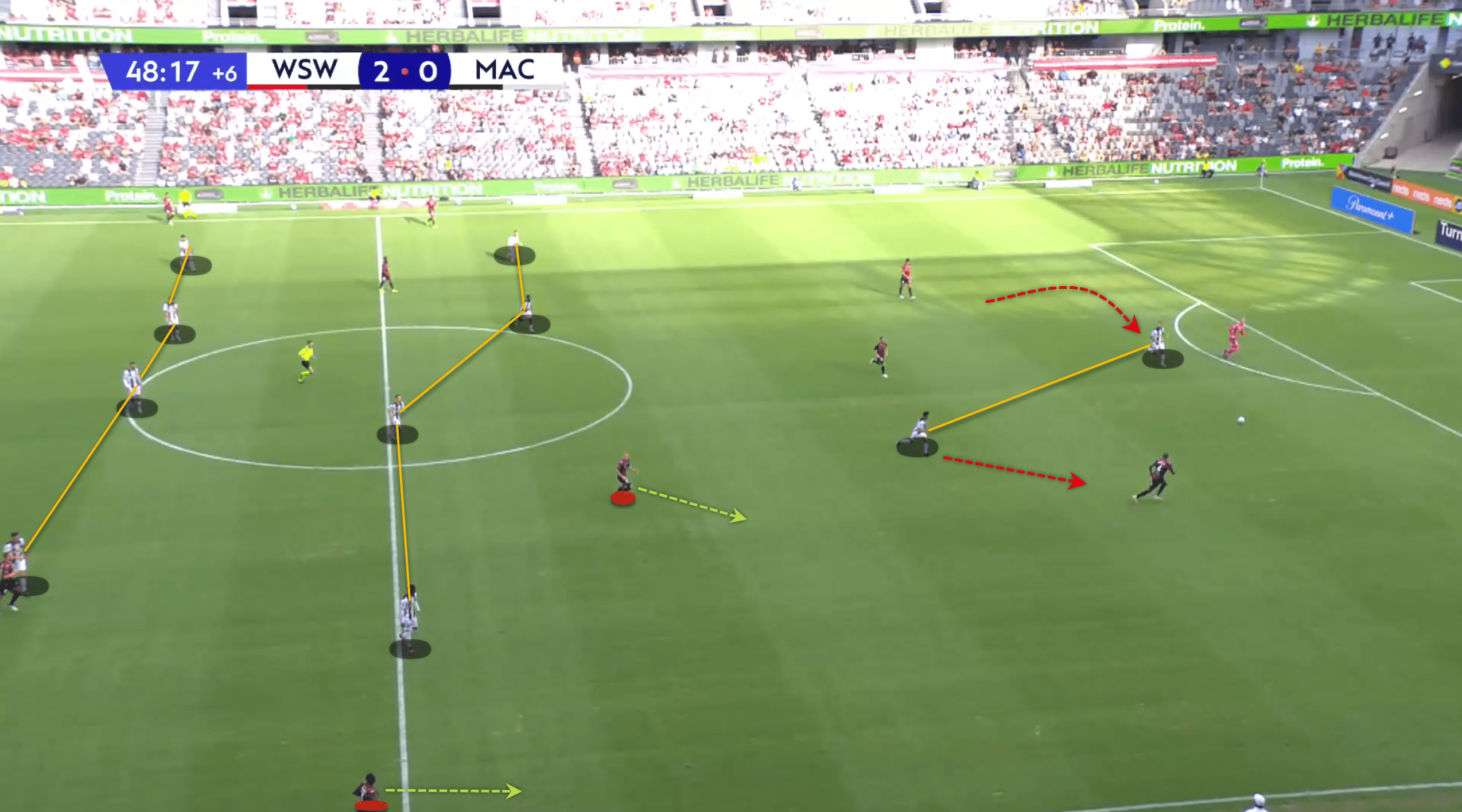
Watch the space in the above image between the attackers who press and the midfielders who look far off. Dávila and Arabuli pressed the ball, but the midfielders were lacklustre and continually left space. Noone was left unclear how/whom to mark, thus his marking skill was the most critical.
The centre-backs of Macarthur were very comfortable having the ball and roaming around to find the right pass. Nieuwenhof’s positioning dragged a few attackers and gave room for the defenders to use the space upfront.
In the below shot, he drops between the centre-backs, allowing Marcelo’s dribbling skills to come into action. After attracting Noone to engage in the duel, Traoré had plenty of space and time. Cleverly, Bozanić drops into the space which Nieuwenhof left.
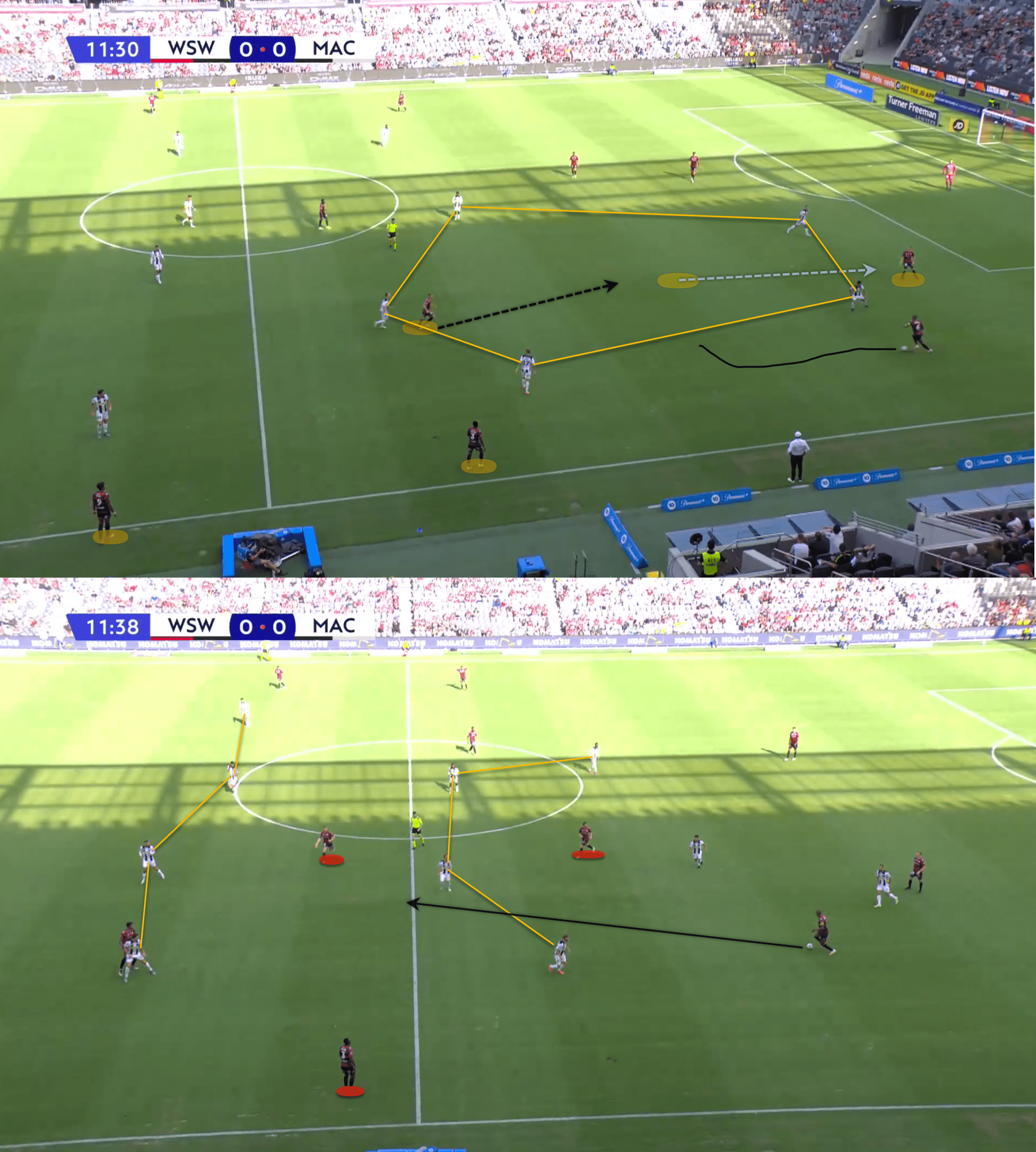
Bozanić passes Hollman to get to the half-space between the midfield and defensive line eight seconds after the top photo. His contribution to support his teammates up and down destroyed Yorke’s plans.
The team’s easy build-up was due to Marcelo’s offensive plot as he lured players with passes into space. The below picture is a very similar situation. Just a ten-meter dribble by Marcelo and an easy penetration by Nieuwenhof saw Yorke’s midfield fall to pieces.
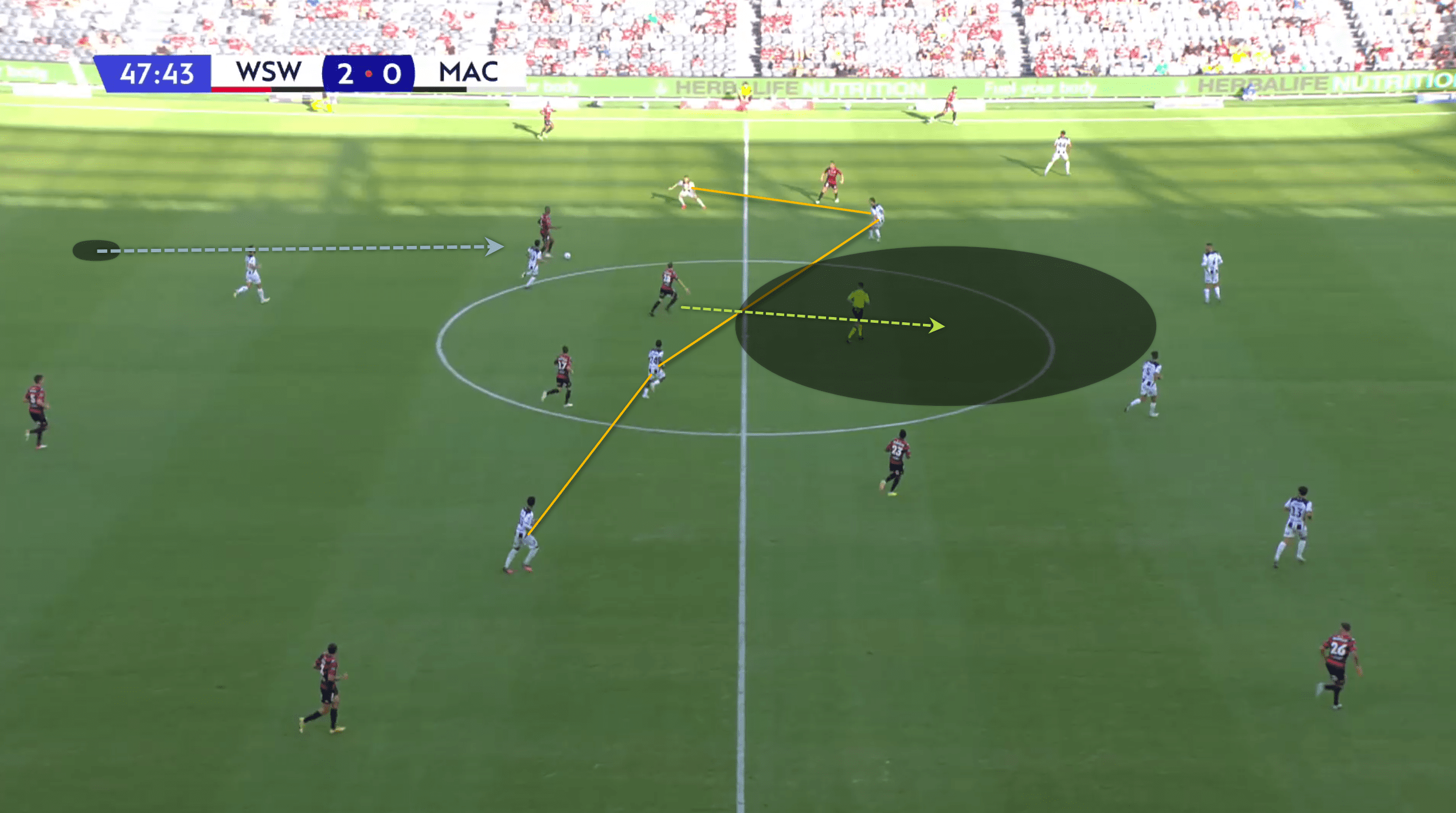
The back four were the least involved in all of the presses in the game. Simply said, WSW outplayed Macarthur in the first half, which gave them huge momentum heading into the break.
Macarthur’s inability to press in the first half was also seen in the second half without any changes. Every player seemed to press at their mood swings as everyone’s press rhythm was different. In the latter stages of the second half, their intensity to press was only seen as mentally aggressive but not sensibly tactical.
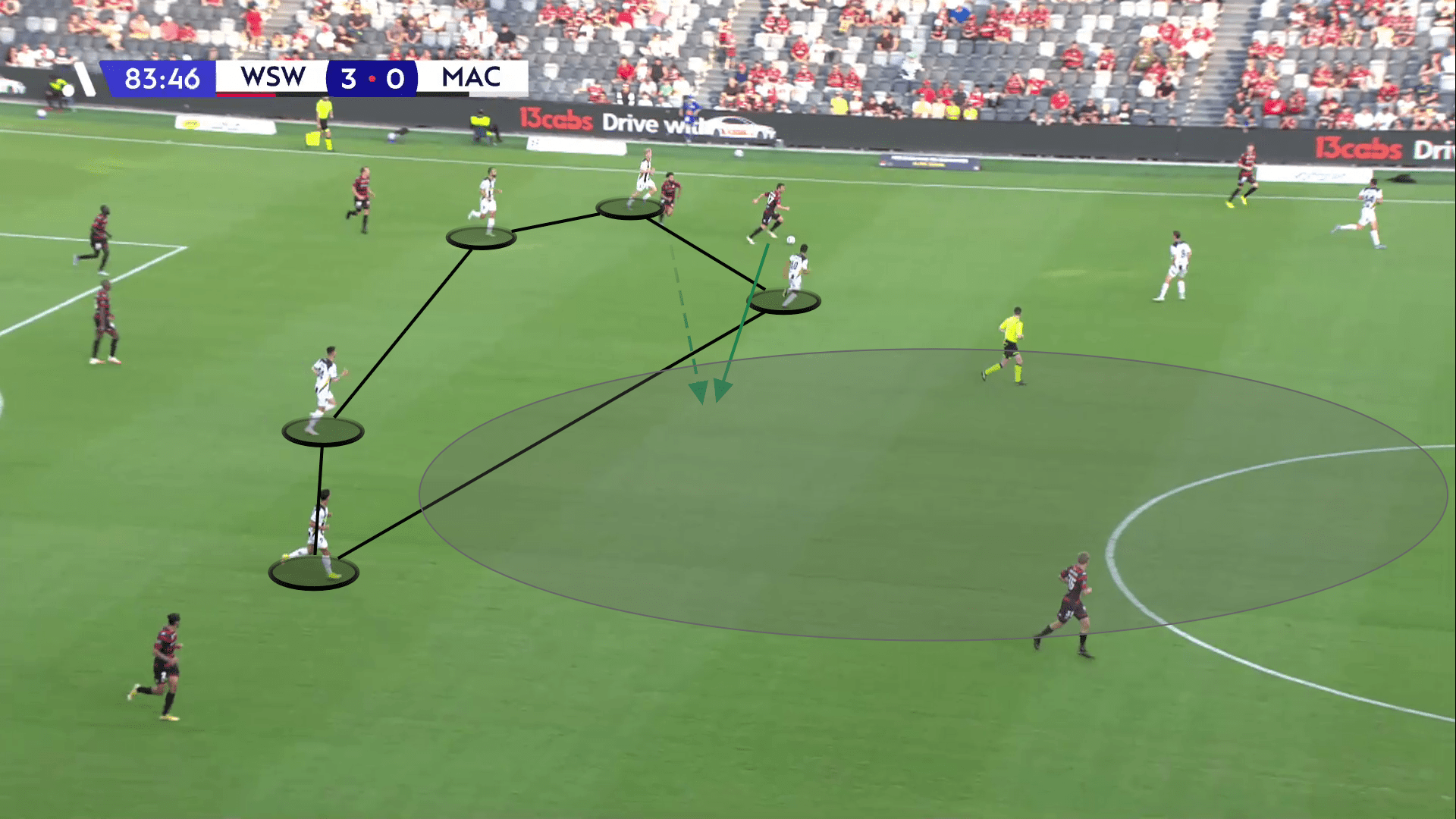
When applying pressure, the awareness to also check if the team is pressing is one important part of the game. In the modern era, this wouldn’t be tolerated, as anyone would stand a chance to take Macarthur to the ground. Each took turns pressing alone and getting beaten, giving WSW a lot of room as in the above photo.
To break out from a narrow-minded mindset, the manager must embody this insight or make it accessible to the players. This game would prove to be Yorke’s most important learning experience as a manager.
Lastly, let’s look into how WSW sensibly knew pressing did not work out and stayed back to maintain its structure. The two different scenarios in the game show how sensibly Rudan wanted his team to defend.

In the opponent’s half, WSW’s top half constantly glanced around to be aware of the structure. The pressing techniques used by both managers were the main distinction between the two sides.
Inability to find the right spaces
Macarthur found it just so hard to get through the defensive structure of the Wanderers. It seemed like the attacking midfielders and the wingers weren’t in sync at all. They were unable to combine and cut through the middle to create chances.
The team’s backbone, Hollman and M’Mombwa, were eliminated before they had a chance to strengthen their position. Before entering the final third, the build-up phase complicated them the most. The midfielders’ awareness to stay tight and create combinations was visibly insufficient.
In a formation like 4-2-3-1, the structure used to overpower the midfield was toppled by Yorke. His idea to make the team very wide put him in a lot of trouble. Macarthur’s structure in possession looked like they were all scattered and so in a different world.
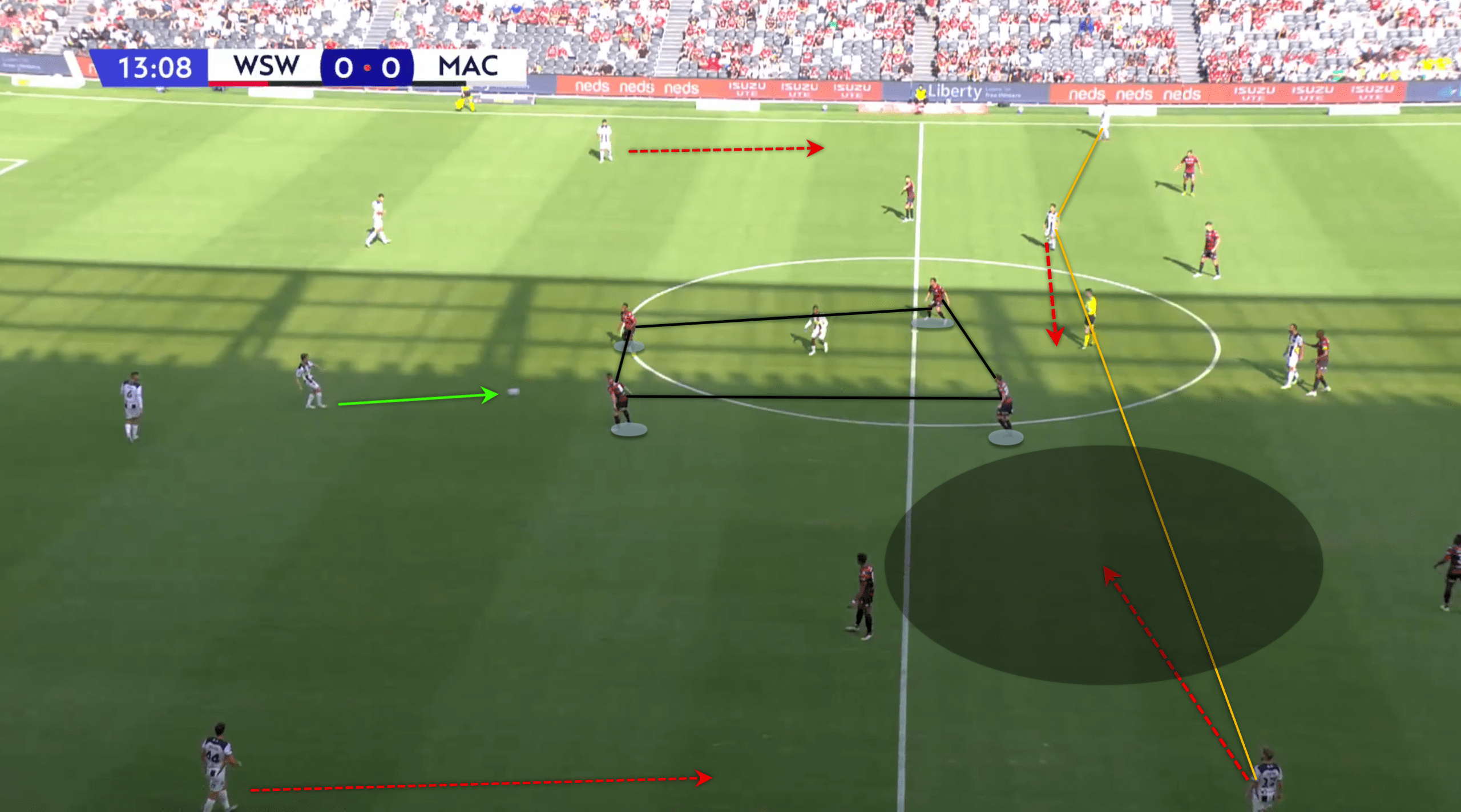
In the early stages of the first half, Hollman dropped deep to allow M’Mombwa to position high up. But the real issue was Yorke’s attacking three being wide apart from each other. In the below image, the trio marked in yellow looked torn apart rather than moving inside to create plays. The first-time ball from M’Mombwa might have threatened WSW’s midfield if Noone and Dávila had arrived in the marked areas.
Was it Yorke’s advice not to stay tight and spread out? Well, that sounds like the case. His instructions were well-communicated as none of them made the effort to come inside and try the spaces.
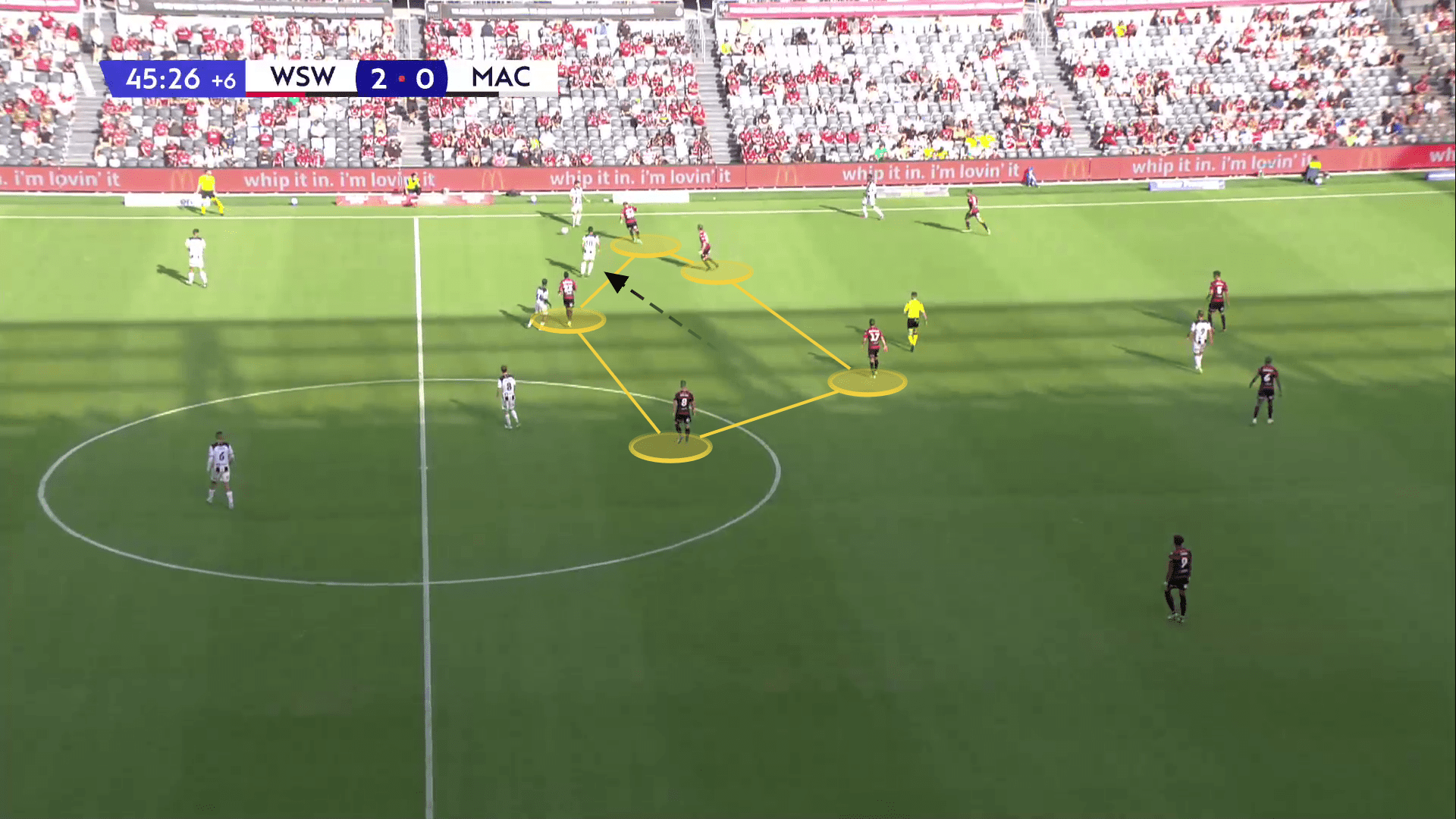
Dávila, as a number ten, had to be the playmaker of the team in the attacking half. The rationale for his participation was his ability to create situations with rapid passes but his presence was barely visible because of his one-sided participation on the pitch.
He was not permitted to operate in the central area because the crowd took him nowhere. When he came to the sides, he wasn’t able to do the best he could.
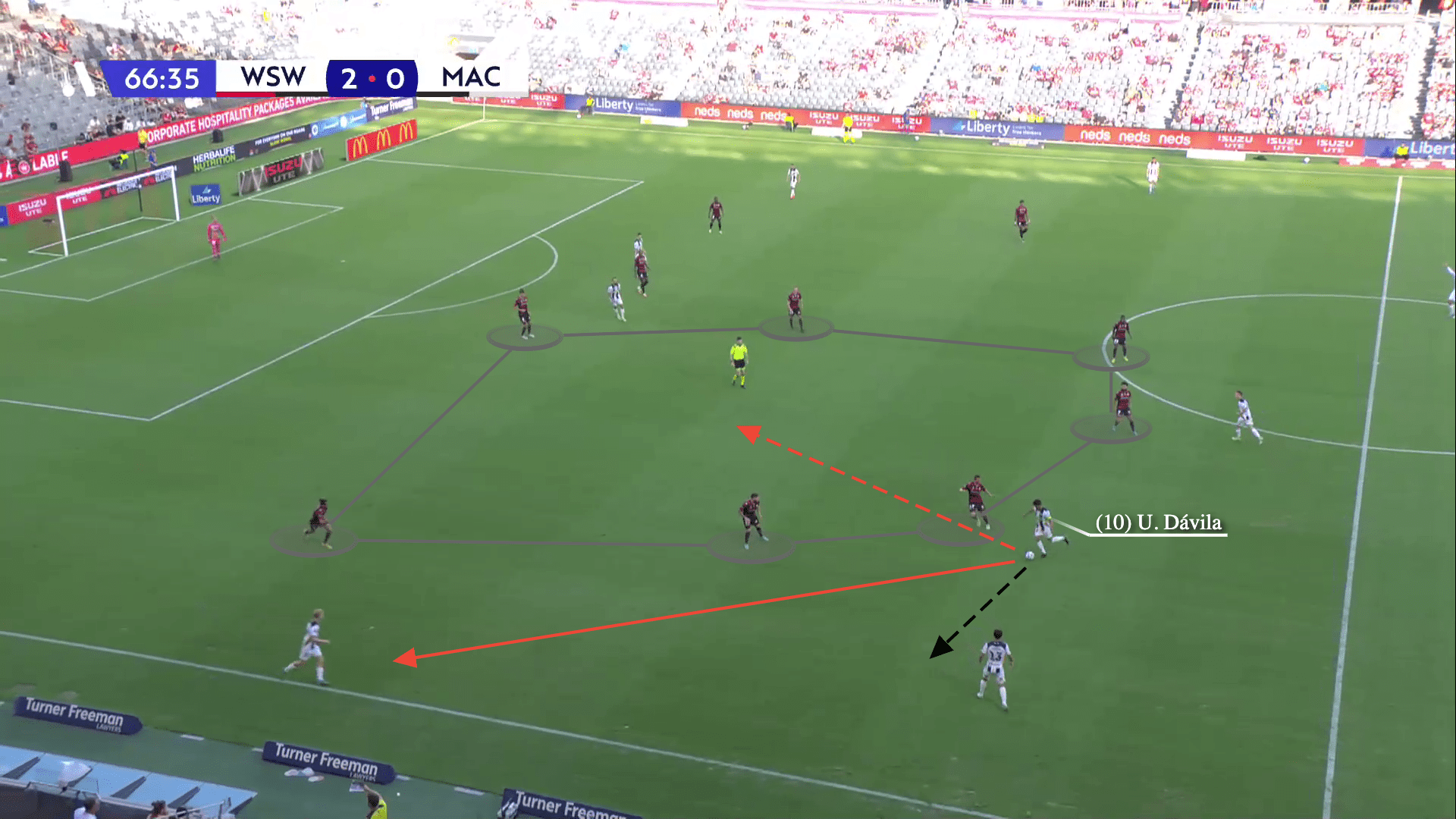
After he dropped down to touch the ball more often, his intention to position higher was long gone. He preferred to stay back rather than go up to the attacking midfield spaces. Together with the flank man, he decided against exploiting the loose formation seen in the above illustration.
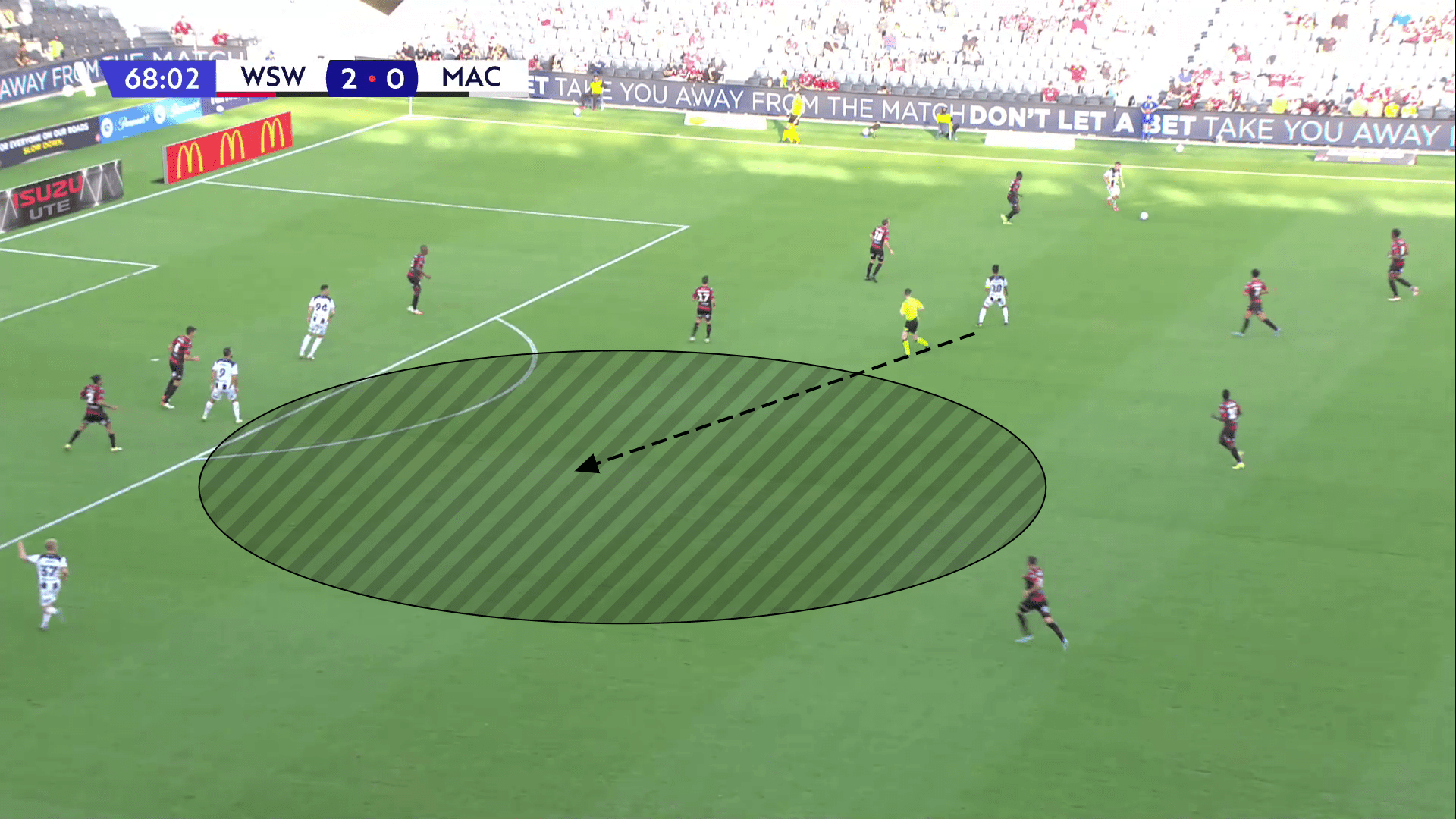
Unlike Macarthur, Western Sydney’s midfield carried out most of the operations. The whole team’s mobility was based on it. The way Amalfitano was able to hold the ball and turn away was superb. He and Nieuwenhof combined well to make Rudan’s ideas run like clockwork.
The only reason Rudan’s plans worked wonders was the midfield being tight and creative to play rapid passes. The sole aim was to counterattack, as Macarthur’s defensive structure allowed them. Bozanić, in the attacking midfield, was at his best. His duty off the ball was to occupy the half-spaces at the correct time to receive.
Thus Macarthur’s major playmaking flaw allowed Western Sydney’s midfield to establish momentum. Yorke’s intentions to create a threat were utterly dismissed as they managed to take only one shot on target. The Wanderers took an astounding 8 shots on target, with the total number being 17.
Facile use of defenders
The major difference between both teams was the usage of defenders during the build-up and in the attacking phases. Any player who held the ball from the home team had multiple options to widen the attacking spectrum.
In the later stages of the first half, Macarthur’s press still seemed to give hope as they tried hard to win the ball. Millar, the right-back, was specifically disinterested in joining the press, leaving tonnes of space above him.
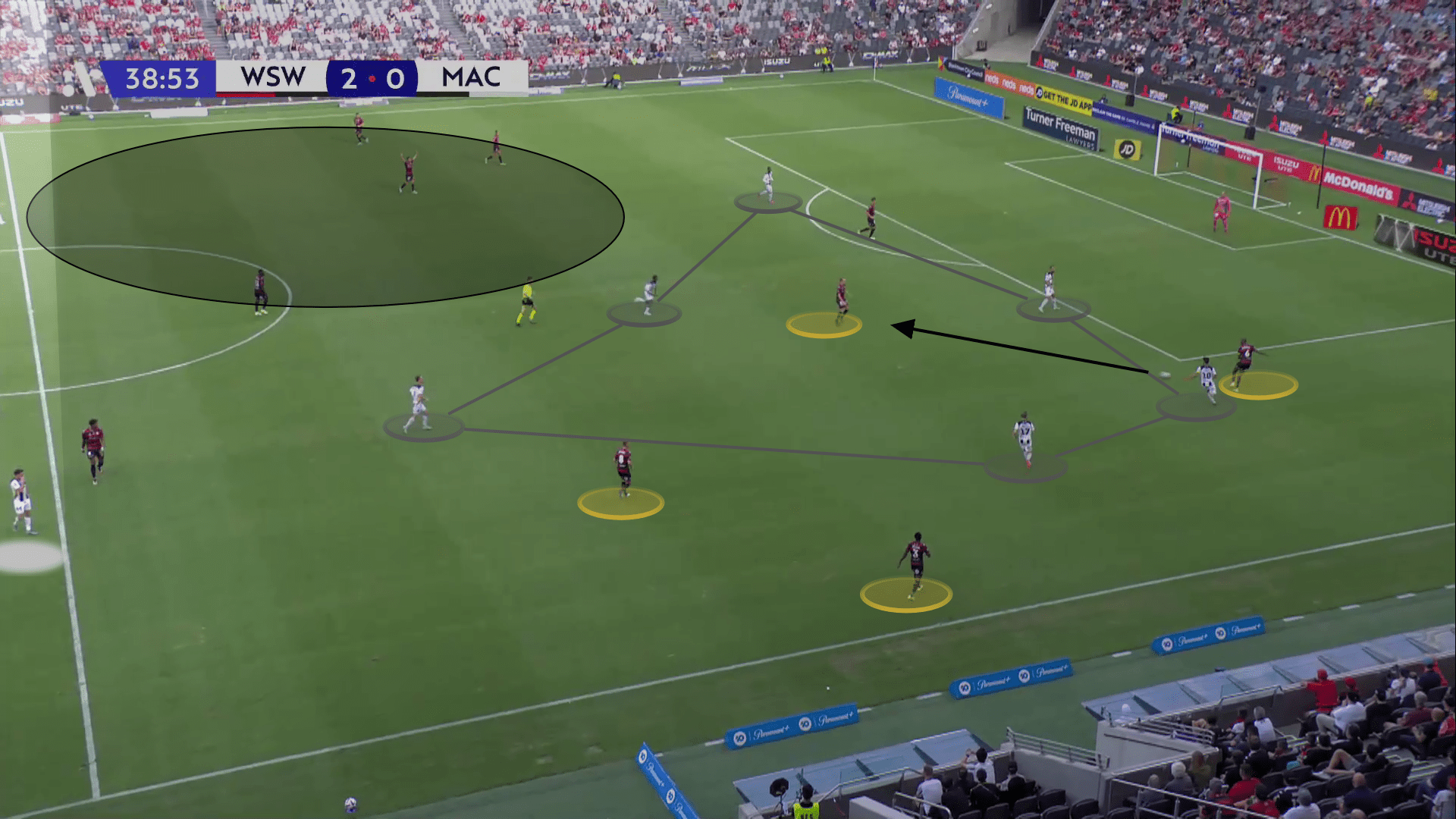
Pressing should be teamwide, not departmental. After seeing half the squad throw themselves out to win the ball, a right-back was seen walking. He was satisfied staying with the man who the centre-backs should have taken care of.
For an attacking team who seeks to attack and create a threat, Yorke’s men were not the ideal side. Millar’s role in the attack has been shown in the example below. His employment in the flanks to create an overload has been his biggest loss.
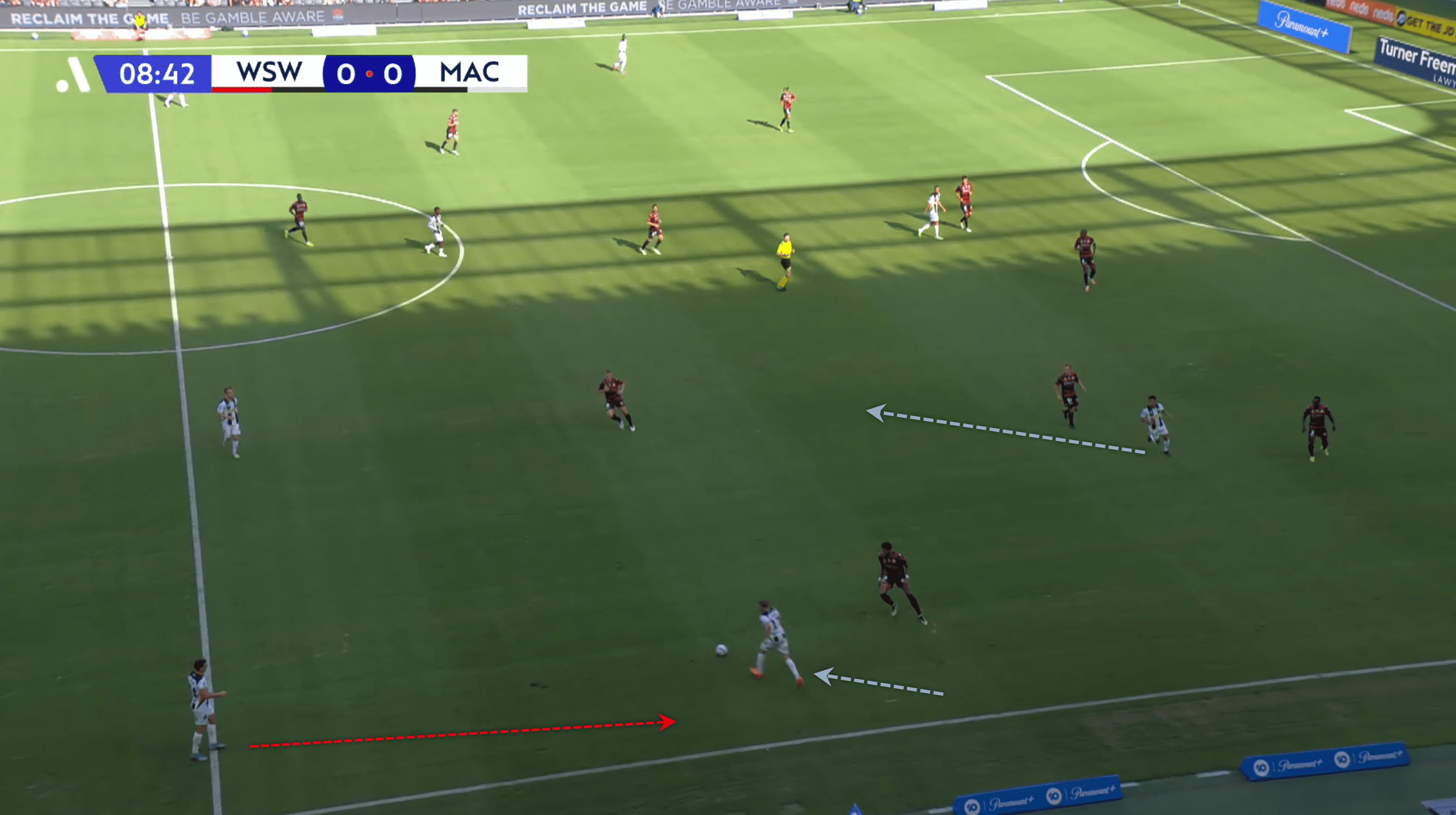
While Noone cuts like any winger would, Millar is seen just seated behind and only playing if the ball comes to his feet. This contributed to significant difficulty in creating space while attacking.
Rudan maximised his fullbacks. Cléùr runs from below to above, spanning 60–70 yards. Given it was the 86th minute, this underlap to penetrate channels was remarkable. After receiving a through pass from Zachary Sapsford, he received the winning penalty to seal the win.
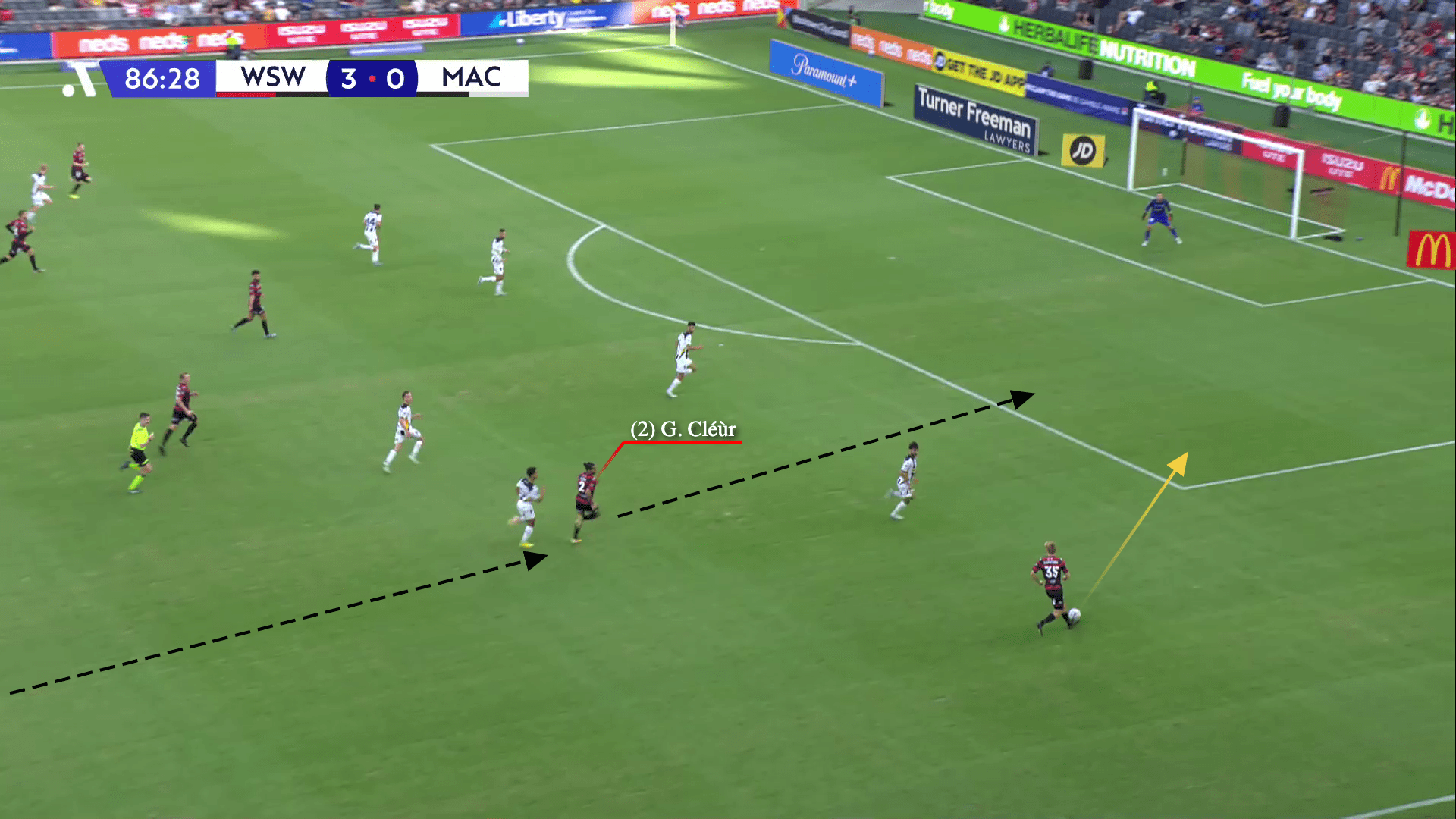
For the Wanderers, the key moments were especially carried out by the defender who won the ball. After winning a loose ball/duel, the first response was to dribble up front and make passes to start the counterattack. As shown in the preceding topics, each defender was given precise instructions on how to do their duties.
However, such wasn’t the case for Macarthur. There was little overlapping or crossing from the fullbacks, and they were seldom utilised at all. As the game progressed, they just followed the ball up and down the field. Nobody could do anything to change the outcome of the game for them.
It was the defenders who contributed to the team’s major disappointment. The centre-backs were handicapped in attack as their involvement was to a minimum just like the full-backs.
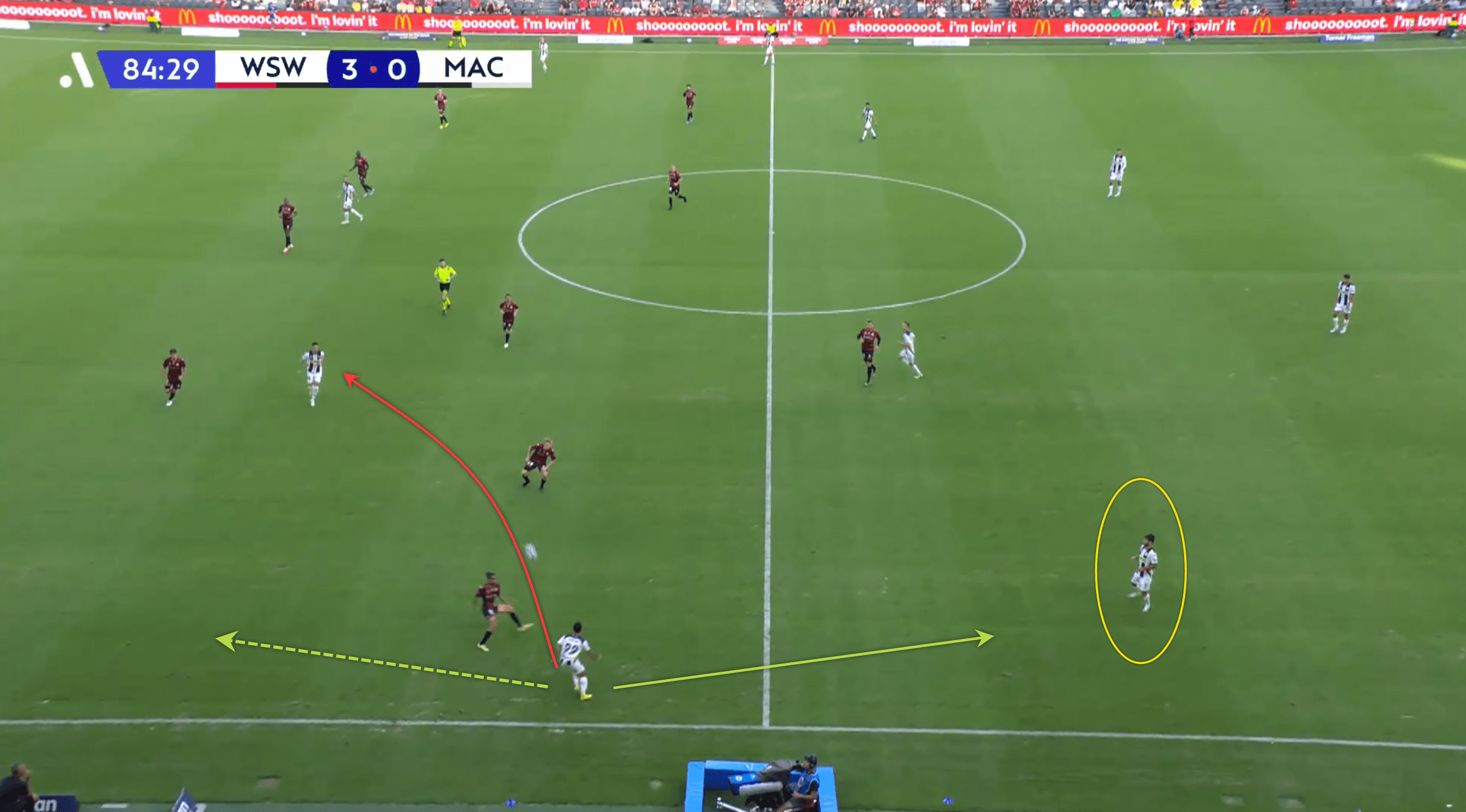
Yorke’s defenders dared to move up front to face an attacker rushing towards them. They merely rotated the play, and nothing more. Macarthur played with four fewer players with the ball, as to conclude it.
Daniel Arzani, the 23-year-old Iranian, was brought on after the 70th-minute mark to replace Noone on the right. He gave Yorke optimism in the latter phases after spending four years at Manchester City without playing.
Anthony Carter, the substitute, puts it in a tight spot instead of passing to Vujica and running behind the defender. This was often seen and Yorke seemed to be happy about what he was seeing. That was the most surprising. To ignite the number of attacks with fluency, the full-backs are to be exceptionally effective. Both Millar and Vujica only needed to locate a teammate to pass the ball to. Nothing more was expected from them.
The full-backs could have sought to overwhelm the flanks since the home side was close-structured. The Wanderers’ tight defence had an easy day of it because of the lack of attacking vigour and passion.
Conclusion
Altogether, despite being unemployed in the last few years, Dwight Yorke has been given credible trust by fans. The issues discussed in the analysis were his biggest takeaways yet, as the game was his heaviest loss as a manager of the team.
In all of the topics discussed, pressing has to be the major part of his philosophy. Pressing decides the tempo and intensity of the game as well as the team’s morale. Losing tempo whenever you had pressed unsuccessfully offers no room for improvement. Thus, Yorke would start to see the loopholes and start to develop his defensive style more than attacking.
In the end, Macarthur easily won against the press, making this a very instructive game for Yorke. Nonetheless, Macarthur suffered when the Wanderers decided not to press.
The new manager Yorke, who guided Macarthur to their only trophy in October, learned the most tactical of lessons. After winning the Australian Cup, he had a fantastic league start, but his worst setback came against Rudan’s side. However, with just six months of experience, he has many opportunities to explore and fine-tune his approach to shaping his philosophy.





Comments